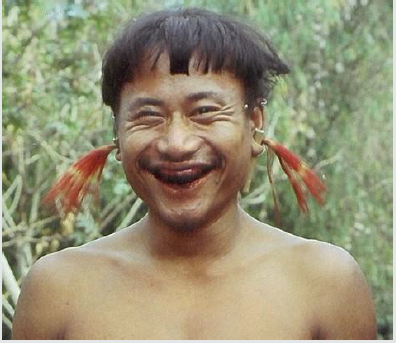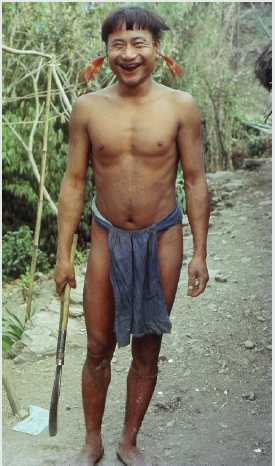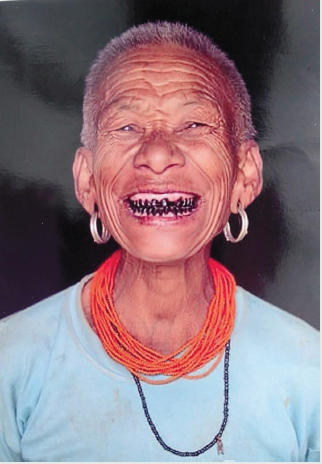
Lupine Publishers Group
Lupine Publishers
Menu
ISSN: 2690-5752
Short Communication(ISSN: 2690-5752) 
The Black Teeth of Wancho Volume 2 - Issue 4
Padmini Tolat Balaram*
- Silpa-Sadana, Visva-Bharati, Santiniketan, India
Received: July 17, 2020 Published: August 07, 2020
Corresponding author: Padmini Tolat Balaram, Silpa-Sadana, Visva-Bharati, Santiniketan, India
DOI: 10.32474/JAAS.2020.02.000143
Usually the pearl white teeth are considered beautiful and most desired in the modern world. Several toothpaste advertisements promote their toothpaste brands by mentioning how they help getting sparkling white teeth! This rise a question:
Why Do Wancho Colour Their Teeth Black?
Wancho have a few reasons of their own. They consider black teeth beautiful. Some tribes feel what is the difference between human being and animals? Animals also have white teeth and the human beings also have the white teeth! So, to differentiate one’s self from animals, it is believed they started colouring their teeth black.
Apart from these, teeth are also coloured to protect them from decaying. The life of each tooth is thus increased if coloured black, as the paint protects the tooth from infections and decays.
Focus of this Article
The following article focuses on the tradition of colouring teeth black, among the Wancho. Apart from Wancho, there are other tribes of Northeast India, as well as of Southeast and East Asia, which practice this art. Due to the limited space, these would be dealt with in the next two articles.
Who are Wancho? Where are they located?
North-eastern part of India is the house of many ethnic groups staying in the hills. Wancho is one of the ethnic groups called tribe in India and ethnic minority in China.
Earlier each ethnic group stayed in their specific area consisting of several villages and specific hills and forests. In a village, only one tribe would stay. However, different clans belonging to the same ethnic group could stay together in the same village.
Wancho were earlier mentioned as Konyak Naga. Today, the Konyak Naga stay mainly in Northern region of Nagaland and are still called Konyak Naga, but the ones staying in Tirap district of Arunachal Pradesh are known as Wancho, which is pronounced as Wanchoo. However, some Wancho could still be found in Tuensang district of Nagaland and in Myanmar across the Patkoi mountain range.
Wancho still share many similarities with Konyak and intermarry with Konyak. Tirap district of present Arunachal Pradesh was a part of Naga Hills during British rule in India. Presently, Wancho stay at the tail end of Tirap District in Arunachal Pradesh, in the area between Longdin and Pongchau. Pongchau is just a few kilometres from Burmese (Present Myanmar) border. One could see the Burmese mountains from Pongchau. However, in 1984 when I was there, there was no road to Myanmar from Pongchau. But the Wancho easily climbed the mountains and reached Myanmar across the valley. Wancho are extremely brave and skilled warriors, who could never be conquered by British!
Social Status Among Wancho
A Wancho King could have several wives, all staying together in one large house along with their children. Wancho are divided in 5 categories. All their villages have a King. In Assamese he was called as Gambudha, meaning the elder one of the village. Social status of Wancho as per hierarchy is as below:
a)
Wangham, the King of the village, as well as his sons from a Wangcha, the queen.
b)
Wangcha, the queen as well as daughter of a Wangham and Wangcha.
c)
Wangsa, a child born to Wangham (King) by a Wangpen, a wife from the common Wancho.
d)
Wangsu, a child born to Wangsa by a Wangpen, a wife from the common Wancho.
e)
Wangpan, the general public and the commoners. This is considered the lowest community among Wancho.
The dress, the hairstyle, the tattoos all differed as per the category the Wancho belonged to. All the Wancho coloured their teeth black, irrespective of their social status.
Process of Colouring Teeth Black among Wancho
There are various ways used by Wancho for colouring their teeth black.
Process of colouring their teeth is like brushing one’s teeth
I. By using mesh (burnt carbon) of Puwakmai tree
a. First the wood of puwakmai tree is burnt
b. Iron blade of the dao is cleaned. Dao is a special tool used for
cutting trees as well as animals)
c. The burning wood is kept very close to the dao blade.
d. Thus, the slightly liquid carbon of burning wood is collected on
the metal blade of dao.
e. Wancho apply this carbon on their teeth.
f. They even clean their teeth with the carbon by applying it on
their teeth.
g. However, this cleaning of the teeth is not carried out every day.
h. They usually clean their teeth at night whenever they feel their
teeth or mouth dirty.
i. Minimum 2 to 3 days in a month, brushing with carbon made
by burning the wood of puwakmai tree is carried out.
j. The repeated application of this carbon dyes their teeth into
jet black colour.
By Using a coal called wanhan
At times coal known as wanhan is also powdered and mixed with with other two natural ingredients are used by Wancho to color the teeth black. They apply the prepared paste on teeth to colour them black.
By eating fruits of Maipu tree
Wancho also eat fruits of Maipu tree, which colours their mouth black. However, this black colour is temporary and fades after sometime. So to colour again, they would need to eat that fruit again (Figures 1-5).
Figure 1: Wangham, the king of Pongchau village had coloured his teeth black. He is also wearing earrings made of bamboo and goat’s hair dyed red. Photo Credit: Padmini Tolat Balaram, 1984.
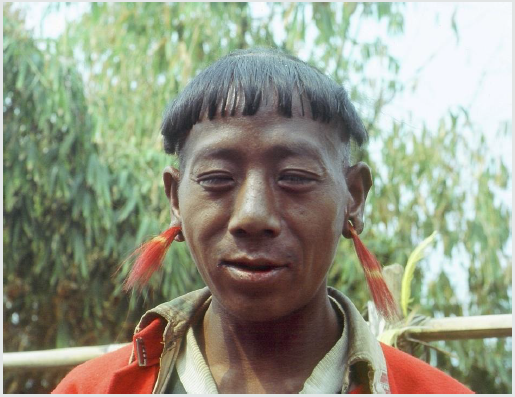
Figure 2:His wife, Wangcha, the queen, also had black teeth and red lips both coloured using local materials and herbs.
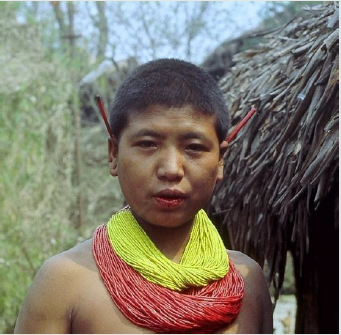
However, colouring teeth black was a tradition practised by various Hill tribes of Eastern Himalayas, Naga Hills and Manipur in India. Due to the limited space, I would write about this tradition in other parts of Northeast India and in the various parts of Southeast and East Asia in next articles.
Works Cited
Balaram Padmini Tolat, ‘Natural Dyes of North Eastern India: Arunachal Pradesh, Nagaland, and Manipur (A typed manuscript) Ahmedabad, 1984

Top Editors
-

Mark E Smith
Bio chemistry
University of Texas Medical Branch, USA -

Lawrence A Presley
Department of Criminal Justice
Liberty University, USA -

Thomas W Miller
Department of Psychiatry
University of Kentucky, USA -

Gjumrakch Aliev
Department of Medicine
Gally International Biomedical Research & Consulting LLC, USA -

Christopher Bryant
Department of Urbanisation and Agricultural
Montreal university, USA -

Robert William Frare
Oral & Maxillofacial Pathology
New York University, USA -

Rudolph Modesto Navari
Gastroenterology and Hepatology
University of Alabama, UK -

Andrew Hague
Department of Medicine
Universities of Bradford, UK -

George Gregory Buttigieg
Maltese College of Obstetrics and Gynaecology, Europe -

Chen-Hsiung Yeh
Oncology
Circulogene Theranostics, England -
.png)
Emilio Bucio-Carrillo
Radiation Chemistry
National University of Mexico, USA -
.jpg)
Casey J Grenier
Analytical Chemistry
Wentworth Institute of Technology, USA -
Hany Atalah
Minimally Invasive Surgery
Mercer University school of Medicine, USA -

Abu-Hussein Muhamad
Pediatric Dentistry
University of Athens , Greece

The annual scholar awards from Lupine Publishers honor a selected number Read More...





